 |
||
|
||
| ||
By Maxim Lyadov
IntroductionNot so long ago a user on deciding to buy an acoustic set for his home theater (intended for computers) saw three main alternatives (according to price increase): The first variant is a set of computer plastic sound imitators at $100-250 with 2-3" in diameter diffusers and 3-10 W RMS for each speaker, plus a plastic subwoofer with a lot of holes for ventilation - it's not the best choice for system's acoustics scheme for the good low frequencies. However, it will suit games (frequency of sound effects is rarely higher than 11 or 22 kHz) and for DVD-movies with Dolby Digital 5.1 (see below "why?"), and of course for MPEG-4 discs. The second variant is a set made with improvised means, you should just add to the quality (of Hi-Fi level) system missing elements (how you can do it I wrote in my article Santa Cruz sound card review ). Such set is more preferable as far as music is concerned than the first one. But there are some downsides. First, overloading of a computer corner with different stuff and cables. Secondly, a possible necessity in buying of a separate decoder Dolby Digital 5.1 and DTS. It means that additional costs will be $200-600 depending on what you want. And the last alternative is a decent audio system for serious non-computer home theater. It won't be cheaper than $1000 in most cases. Well, the market was waiting for some kind of a compromise. And at last, we can see something similar from many manufacturers now. In this article we will talk about two sets of such acoustics from VideoLogic. Meet - DigiTheatre and DigiTheatre DTS. Their price by the end of 2000 will be approx $400 and $650 correspondingly. DigiTheatreTotal power of the acoustics is 62.5 W RMS and 1000 W PMPO. Total weight with enclosure constitutes 15 kg. The complete set includes:
Note that the front speakers are connected with a joint. However, I couldn't find any position which would make a big difference for me. 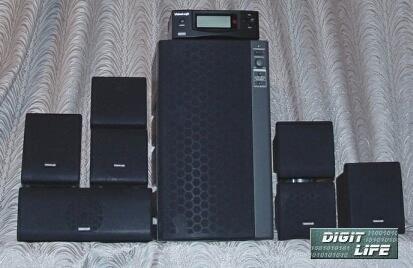 Let's consider it a bit deeper. Note that Dolby Digital decoder is implemented separately from amplifier cascades (which are in the subwoofer) and has the following inputs:
From a decoder there goes a special thick cable with 6 RCA connectors. So, adding to this complete set a sound card with 6 connectors (TB SantaCruz, Creative SBLive! 5.1, Genius SoundMaker 5.1 etc.) you can eliminate limitation on hardware decoding only of Dolby ProLogic and DolbyDigital. There arises a question - what is this decoder for if its decoding functions can be implemented by any modern card with 6 outputs and by software DVD player? For answer this question, look at its "face":  The first, the second and the third are that this one very comfortable. Lying on a sofa, you can set everything using a remote control, choose a required working mode of the decoder, adjust the volume for each speaker separately or for all in bulk. Besides, if you get tired of working and you feel like listening to music you can leave only front speakers and a subwoofer with only one click on the remote control (without hundred crazy mouse's clicking into deep of utilites). There are sound cards with remote control also (for example Creative SBLive! 5.1), but they have instant only volume and tone control, without ability for quick changing of speaker modes. A bit of clarity: after the article was composed I decided to check again a price for this complete set. Interestingly that beside these two systems I found two more positions: DigiTheatre LC and DigiTheatre PC. The former (LC stands for Low Cost) is a pure DigiTheatre without the aforementioned decoder, but its price is twice lower! The latter is a combo of DigiTheatre LC + VideoLogic SantaCruz (it's a european variant of Turtle Beach SantaCruz, it differs from the original only on the soft set). 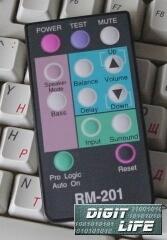 Look at this minute remote control. It's only 5 mm in width, and the battery that feeds it is very flat. I watched DVD movies and listened to the music in a room (3 m x 4 m) without much furniture. The sound in DVD seemed rather convincing. Acoustics reproduced decently sound track recorded in Dolby Digital 5.1 (AC-3) format. And a specific sounding of middle frequency speakers smoothed out artifacts of a standard for DD5.1 64 kb stream. Although plastic is not very good for music, as I suppose, the developers tried to do their best with the appropriate speaker geometry, acoustic material and rubber pads in points of support. Even the cables are very decent: copper, 1 mm in diameter and long enough for most cases (4 meters for front and central ones and 6 meters for rear speakers). We compared how it sounds when playing songs in comparison with AIWA audio component system (with two plastic speakers, 10 W RMS, 50-12000 Hz) because of similar speakers. On the photo you can see the front speakers standing on the speakers from AIWA. For you to compare acoustics sizes we set here a 15" monitor and a keyboard. 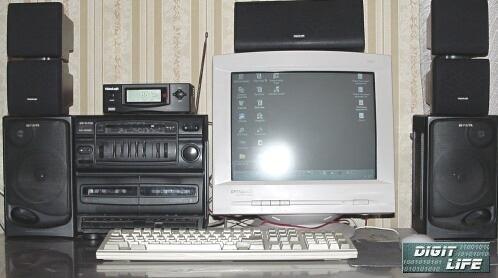 Despite pessimistic forecasts the speakers from VideoLogic DigiTheatre sounded much better at highs and middles that their plastic brothers from AIWA. And when turning on a subwoofer we got decent lows. Well, the summary. For electronic, dance and pop music the sounding is quite good. As for classical and jazz music the sound is not that good (and it's was being said the very soflty). DigiTheatre DTSA little of theory on "DolbyDigital vs. DTS". Considering that a sound track is decoded in 16 bit 48 kHz we received the following: 48000 Hz * 16 bit / 1 k = 750 kbps decoded stream. Now, according to the last version of http://www.dvddemystified.com/dvdfaq.html and with practice of DVD disks market we receive: DolbyDigital5.1:~80% movies with DD5.1 have an audio stream in 384 kbps = 64 kbps * 6 channels. 750 kbps : 64 kbps = 11.7 ~ 12x compression ~20% movies with DD5.1 have an audio stream in 448 kbps = 96 kbps * 2 front channels + 64 kbps * 4 the rest. 750 kbps : 96 kbps = 7.8 ~ 8x compression DTS:768 = 128 kbps * 6 channels. 750 : 128 = 5.9 ~ 6x compression 1536 = 256 kbps * 6 channels. 750 : 256 = 2.9 ~ 3x compression(!) Note that in the DTS a central channel and subwoofer channel are not combined. It ensures more qualitative reproduction of speech and effects. Let's compare it with something more familiar. For example with MP3 (and don't say me that they different depend on algorithms, they have the one principle inside - lossy compression). Since MP3 has two channels (that is stereo), DD5.1 corresponds to 128 kbps of MP3 (maximum for DD5.1 it is up to 192 kbps but such stream is only for front speakers). For DTS it's 256 kbps of MP3 (and the limit is 512 kbps). As for movies in DTS, you can look though a list on the official site of the developers of this standard www.dtsonline.com. Today there are more than 150 movies with DTS for the first zone and about 50 are coming soon. The second set from VideoLogic contains the letters DTS in the name. It means that the decoder can decode hardwarely DTS as bonus. PCM Stereo, Dolby ProLogic & Dolby Digital decoding also and fine. Look at the picture: 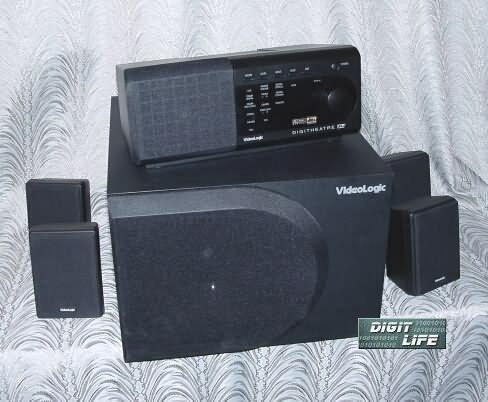 As you can see this set is more considerable. And it costs ~1.6 times more than the previous. The complete set includes:
Total power is 220 W RMS. Gross weight is about 17 kg. It can be characterized with three words: compactness, power, quality. Satellites are quite heavy. They have MDF wooden cabinet, containing magnetically shielded drive unit, from Audax (the firm from Harman International concern). Below you can see how the speakers look. 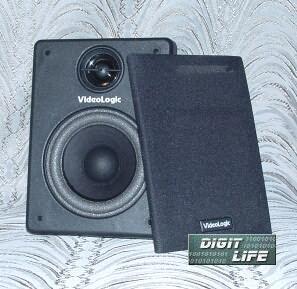 Here is a photo of the subwoofer without a tissue frame: 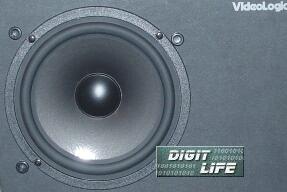 I liked this system much more then previous. Now let's pass to receiver's features which is combined with a central channel. Inputs:
The receiver is connected by a thick 1.5 meter bus. It makes unnecessary usage of a power cord for the receiver, since the power comes in a pair of cables of the bus. In the picture you can see that beside the standard modes Dolby Digital, Dolby ProLogic and Stere there is a mode of decoding DTS. Besides, there are modes received as the result of processing by an internal effect-processor: Theatre and Hall.  A remote control doesn't look as something extraordinary. It's quite small, alike that of VHS player. It feeds from two AAA batteries. As for playing movies, there is something to complain about. The rear speakers when being a meter moved away can't be heard. When I read the recommendation it said that they should be placed on sides and not behind as usual. First I considered it a joke, but then it really solved the problem. DVD with the system DigiTheatre DTS left more pleasant impression than the system without DTS letters in the name. The main advantage is that there is no even a trace of "plastic" sound. For music reproduction this system gets a mark "not bad" in general and "excellent" for computer acoustics. The main downside was a fallen "lower middle" (in AFC terminology slang). For some melodies it wasn't important but others got poor. In general, the DigiTheatre DTS impressed me most of all computer acoustics, that I hear before. As far as the price is concerned, I think that it's appropriate. ConclusionThe VideoLogic DigiTheatre is intended for those who are not satisfied with 2" speakers in plastic case. It's one of the best sets of computer plastic speakers. Very comfortable and stylish remote control. The VideoLogic DigiTheatre DTS is intended for stricter users who want to use computer acoustics both for movies with DTS and for quality MP3 listenning, and more real effects in games. I would call it an intermediate variant between a serious consumer audio systems and easy computer speakers. More speakers at The Speaker Company Online Store. Write a comment below. No registration needed!
|
Platform · Video · Multimedia · Mobile · Other || About us & Privacy policy · Twitter · Facebook Copyright © Byrds Research & Publishing, Ltd., 1997–2011. All rights reserved. |